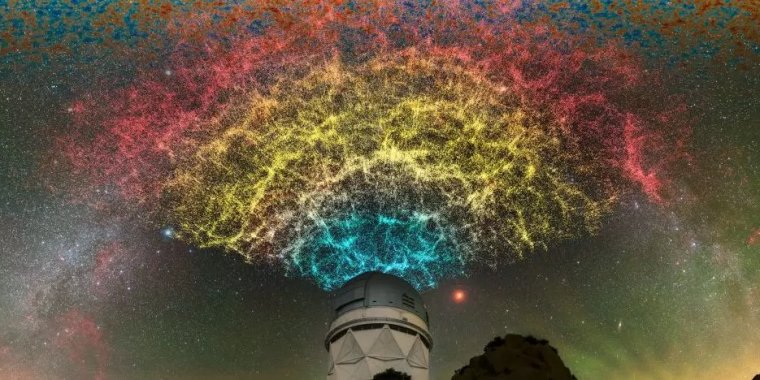| News / Space News |
Dark energy survey looks 11 billion years into the past, reveals most detailed view ever of expanding universe
Researchers have measured the expansion history of the universe with the highest precision ever, providing a more detailed look at the nature of dark energy and its effect on the universe.

An artistic celebration of the Dark Energy Spectroscopic Instrument (DESI) year-one data, showing a slice of the larger 3D map that DESI is constructing during its five-year survey. By mapping objects across multiple periods of cosmic history with extremely high precision, DESI is allowing astronomers to make unprecedented measurements of dark energy and its effect on the accelerating expansion of the Universe. DESI’s map reveals the large-scale structure of the Universe, showing clumps of galaxies separated by voids where there are fewer objects. This pattern is a result of large pressure waves that permeated the early Universe and is reflected in the cosmic microwave background. DESI is mounted on the U.S. National Science Foundation Nicholas U. Mayall 4-meter Telescope at Kitt Peak National Observatory, a program of NSF NOIRLab. This version of the DESI map includes 600,000 galaxies — less than 0.1% of the survey's full volume. The locations of objects in the data slice do not correlate with their locations on-sky shown in this image. Photo: DESI Collaboration/NSF NOIRLab/KPNO/AURA/P. Horálek/R. Proctor
The results are from an analysis of spectra of galaxies and quasars recorded by the Dark Energy Spectroscopic Instrument (DESI). The data is from the first year of a five-year survey which will be used to create the largest 3D map of the universe ever made.
"This project is addressing some of the biggest questions in astronomy, like the nature of the mysterious dark energy that drives the expansion of the Universe," says Chris Davis, program director for NSF NOIRLab.
DESI is an international collaboration of more than 900 researchers from over 70 institutions around the world.
The instrument is mounted on the NSF Nicholas U. Mayall 4-meter Telescope at Kitt Peak National Observatory. The DESI project is managed by the U.S. Department of Energy’s Lawrence Berkeley National Laboratory and funded by the DOE Office of Science.
Detailed in several papers, the researchers presented their analysis on April 4. They report that they have measured the universe’s expansion history over the last 11 billion years with a precision better than 1%.
Those measurements confirm basic aspects of the leading model of the universe's structure and expansion, while also uncovering areas to explore with upcoming data.
While the expansion history of the universe may be more complex than previously thought, confirmation must await the completion of the five-year DESI project which aims to map over 3 million quasars and 37 million galaxies.
As more data are released, researchers will further improve their results. (National Science Foundation)
YOU MAY ALSO LIKE





